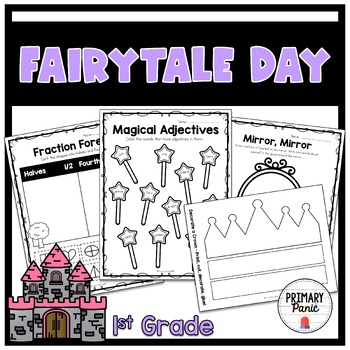Fairytale Day - End of the Year Theme Day Activities for 1st Grade
- PDF
Also included in
- Your last week of school is PLANNED! Theme days are the best way to review important 1st grade concepts while having unmatched, immersive FUN! Students will love putting all their skills to practice with these engaging worksheets, crafts, and activities for Beach day, Camp day, and Fairytale day. LoPrice $9.00Original Price $12.00Save $3.00
Description
The end of the school year is the perfect time for theme days! Review important 1st grade concepts with these fun, fairytale-themed activities. Print it out as one big packet or pick and choose your activities to complete your magical day. Students will love putting all their skills to practice with these engaging worksheets, crafts, and activities.
Pages include:
- Fairytale Day Packet Cover Page
- Story Problems (Addition/Subtraction)
- Fraction Forest (Halves/Fourths)
- Measurement Magic (Centimeter Cube Measuring)
- Story Elements (Key Details of Fairytales)
- Castle Race! (Magic E Board Game)
- Magical Adjectives (Identifying Adjectives)
- Magical Adjectives (Generating and Using Adjectives in Sentences)
- Create a Fairytale (Planning Pages and Final Draft Booklet)
- Mirror, Mirror (Positive Affirmations)
- Scrap Art (Creating a Fairytale Settings)
- Crown Decorating (Printable Template)
- Answer Keys
You may also love my BEACH DAY PACK and CAMP DAY PACK!
Before purchasing, please take a look through all of the previews and thumbnails to make sure this product is right for your students.
I can’t wait to see how you use this resource! Feel free to tag me on Instagram (@primary_panic) when you use this resource and leave some feedback here to tell me all about your experience!
~~~~~~~~~~~~~~~~~~~~~~~~~~~~~~~~~~~~~~~~~~~~~~~~~~~~~~~~~~~~~~~~~~~~~~~~~~~
If you have any trouble with a product or notice a mistake, please let me know in the Q&A forum! I'd love to be able to problem-solve with you.
Have fun!
~Kate
~~~~~~~~~~~~~~~~~~~~~~~~~~~~~~~~~~~~~~~~~~~~~~~~~~~~~~~~~~~~~~~~~~~~~~~~~~~
FIND ME ON INSTAGRAM for HUMOR, AUTHENTICITY, and TECH TIPS!
~~~~~~~~~~~~~~~~~~~~~~~~~~~~~~~~~~~~~~~~~~~~~~~~~~~~~~~~~~~~~~~~~~~~~~~~~~~
Ways to Treat Yourself!!
Get Credit!
- Go to your "My Purchases" page.
- Next to your purchase, click on the "Provide Feedback" button.
- Rate my product and leave a comment. I'd love to hear what you think!
- YAY! Now you've earned credits to use on your next purchases.
Follow Me!
- Click the green star next to my logo on my store page.
- Now you'll be the first to know when I add new products!



